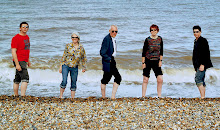In the National Museum in Cardiff there's a gallery round the foyer, given over to Welsh crafts: glass and pottery, silverware and so on. Some of it's fine, but it doesn't interest me much, or at any rate, not as much as it should. Perhaps it's because I'm not feeling 100%. Slipware, oh please; it's nice and homely, but the decoration, the use to which it's put, hardly merits place in a museum. Most of the stuff would be better off in someone's house, being used. What is there about it to be stared at, wondered at? The skill in making? Yes, but it seems skill without purpose: the purpose is curtailed, we are looking only at a small part of the thing's reality. Our imagination must supply context and use, imagine an owner, or at least the hands of the user: this is what it's like to hold, this is how easily it pours, feel its heft, the sound it makes as you place it on the kitchen table. How the light strikes it among the apples and red peppers. The morning sunlight slanting in through the half door, the light reflected off the river, wobbling and shifting.
Somehow it's much easier with something from the past. Contemporary craft is so self-conscious.
And there is a cabinet of de Waals. (That doesn't merit an apostrophe as it's a standard museum cabinet.) Instantly recognisable: two of his tall swaying cylinders placed, I'd have thought, slightly too far apart, and some shallow nested dishes, wide, with straight sides, very thick. Some are nested with their sides touching, some randomly, but they look untidy and haphazard rather than studiedly random. They look as if they have been put in the case by someone other than the artist, someone who's just collected some examples of his work. I can't explain it. If I knew that de Waal had installed it, I'd pay the arrangement a different quality of attention. Instead, they seem to be tired, denatured, uncontextualised. They're pieces in a museum making as much sense as something dug out of a garden when we don't know where the garden is or what the thing is for. The presence of the pots is only part of their meaning. And how naked they are. We can see them, see into them - all except the tall ones, which have their unknowable interiors. Perhaps under the dishes there are marks or colours we will never see. I'd like to think so. And there are no titles - simply 'Edmund de Waal' and some dates, I forget now. I should have made a note. De Waal's captions, titles, are part of how we read his work. So again, I'm wondering if this is after all an installation, if he's deconstructed the museum exhibit to leave the thing stripped down like this, bare, devoid of meaning and context (the title is literally 'con-text'), the unknowable just creeping in when you think you've drained it of meaning. But I doubt it. It's too obvious: it looks as though the museum staff have been able to do that anyway, all by themselves.
23 July 2007
Subscribe to:
Post Comments (Atom)



No comments:
Post a Comment